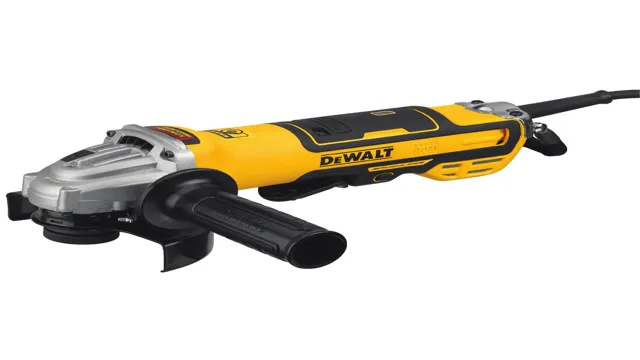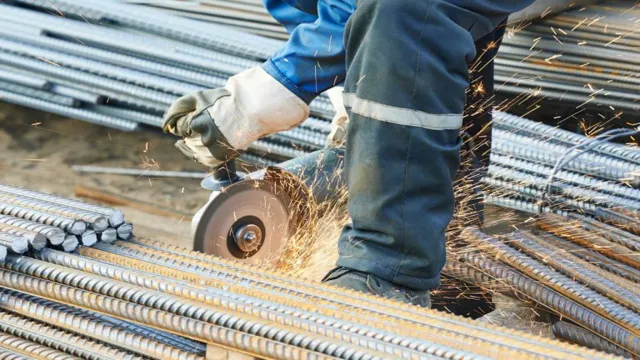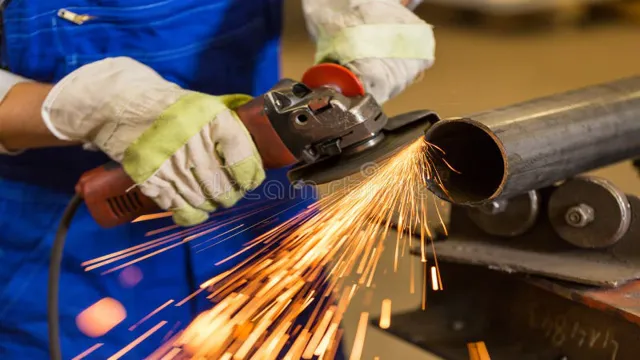
Are you looking to give your dull knife a new lease of life? You might be considering sharpening it through beveling, and an angle grinder is a compelling tool to get it done. Beveling a knife requires a particular skill set, and an angle grinder is one of the efficient tools that accomplishes the task precisely. Learning how to bevel a knife with an angle grinder is a valuable skill that any knife enthusiast should possess.
However, it can be cumbersome if you don’t know how to go about it. But don’t fret! This blog post will provide you with a step-by-step guide on how to bevel a knife using an angle grinder effectively. We will discuss the tools required, the precautions to take, and the beveling process.
Whether you’re a professional or a DIY enthusiast, this guide will ensure that you achieve a well-defined bevel on your knife. Imagine having a smooth and sharp knife that can quickly cut through anything with ease. Sounds exciting, right? Read on and learn how to bevel a knife with an angle grinder like a pro!
Understanding Knife Bevels
If you want to learn how to bevel a knife with an angle grinder, there are a few things you need to keep in mind. First off, understanding knife bevels is critical to ensuring you create a sharp and durable edge. The bevel is the angled edge that forms when you sharpen the knife, and there are several different types of bevels to choose from.
The most common are the standard bevel, the compound bevel, and the convex bevel. Each has its own strengths and weaknesses, so it’s important to choose the right one for your knife and your intended use. The tools you’ll need to bevel a knife include an angle grinder, a sharpening stone, and a strop.
You’ll also need to take safety precautions, such as wearing eye and ear protection and securing your knife while you work. By following these guidelines and using the right techniques, you can create a bevel that enhances your knife’s performance and durability.
Different Types of Knife Bevels
Knife bevels are an essential part of any knife, affecting its cutting ability, sharpness, and durability. Put simply, a knife bevel is the angle at which the blade is ground, creating the sharp edge that does the cutting. Different types of knife bevels can affect how the knife is used and its overall performance.
For example, a flat bevel, also known as a zero grind, is easy to sharpen but lacks durability, while a convex bevel, which is rounded on both sides, can last longer but is harder to sharpen. Other types of knife bevels include the scandi bevel, chisel bevel, and hollow bevel, each with their own advantages and disadvantages. Understanding the various types of knife bevels is key to choosing the right knife for your needs and taking care of it properly.

Choosing the Right Bevel Angle
When it comes to choosing the right bevel angle for your knife, it’s important to understand what a bevel is and how it affects the knife’s performance. Simply put, the bevel is the angle that the blade is ground to create a cutting edge. The angle of the bevel can have a major impact on how well the knife cuts, as well as its durability and ease of sharpening.
A lower bevel angle, such as 15 or 20 degrees, will produce a sharper edge that is great for slicing, but may be less durable and require more frequent sharpening. A higher bevel angle, such as 25 or 30 degrees, will produce a more durable edge that is better suited for chopping and heavier use, but may not be as sharp out of the box. Ultimately, the right bevel angle for your knife will depend on your specific needs and intended use.
So, take some time to consider what you’ll be using your knife for, and choose a bevel angle that will provide the best balance of sharpness, durability, and ease of use.
Preparing Your Angle Grinder and Workspace
If you’re trying to figure out how to bevel a knife with an angle grinder, then the first step is to get your workspace ready. You want to make sure that you have a good amount of space to work in, as well as the necessary safety equipment. Make sure that you have a pair of safety goggles, a dust mask, and a pair of thick gloves to protect your hands.
It’s also important to make sure that your angle grinder is in good working order before you start. Check the power cord to make sure that it’s not frayed or damaged, and make sure that the blade is properly mounted and tightened. Once you have your workspace prepared and your angle grinder ready to go, you can start to focus on beveling your knife.
This process involves removing some of the excess metal from the edge of the blade in a controlled and precise manner to create the desired angle for your knife. It’s important to take your time and work carefully to avoid damaging your knife or injuring yourself. By following these steps and using your angle grinder in a safe and responsible manner, you can achieve a professional-looking beveled edge on your knife in no time at all.
Gathering Materials and Tools
When it comes to preparing your angle grinder and workspace for grinding, the first step is to gather all the necessary materials and tools. You’ll need a few different items, such as a face shield, hearing protection, gloves, and a respirator. It’s important to take your safety seriously, as a grinder can be dangerous if not used properly.
Once you have all the required safety gear, you should also gather the other materials needed for grinding, including a suitable grinding disc, a wrench to remove and replace the disc, and any clamps or vises you may need to hold materials steady while you grind. Next, you’ll want to set up your workspace in a comfortable and well-lit area. You should work on a solid and stable surface, preferably a workbench or table.
Make sure the area is clear of debris or any other items that could get in the way while you’re grinding. It’s also a good idea to mark out a designated safe area around your workspace to keep others from accidentally getting too close. Before you start using the grinder, it’s essential to check the machine’s safety features.
Make sure the power switch is off and the cord is unplugged before adjusting or changing the grinding disc. Inspect the disc to ensure it’s suitable for the material you’re planning to grind and that it’s not worn out or damaged. Once you’ve checked everything, you can put on your protective gear, plug in the grinder, and start getting to work.
Overall, preparing your angle grinder and workspace isn’t too complicated, but it’s crucial to take your safety seriously. By gathering the right materials and tools, setting up a comfortable workspace, and checking your grinder’s safety features, you can safely and efficiently grind materials as needed. Remember to use your angle grinder with care and respect, and you’ll be able to tackle any grinding project with confidence.
Setting Up Your Workspace Safely
When preparing to use your angle grinder, it’s important to set up your workspace safely. Before you even start working with your tool, make sure your workspace is clear and well-lit. This will help you avoid any potential accidents and ensure that you have a clear view of what you’re doing.
To prepare your angle grinder itself, double-check that the disc is properly installed and secured. You don’t want it to come loose while you’re using it! Additionally, make sure that the guard is in place to protect you from any flying debris. It’s always a good idea to wear protective gear, including goggles and earplugs, to keep yourself safe and prevent any long-term damage.
By taking these precautions and being aware of your surroundings, you can set up your workspace and angle grinder for optimal safety and efficiency.
Beveling Your Knife with an Angle Grinder
If you want to bevel your knife quickly and efficiently, an angle grinder is a great tool for the job. First, secure your knife blade in a clamp or vise to keep it steady. Then, attach the grinding wheel to the angle grinder and adjust the guard to protect yourself from debris.
Now it’s time to start grinding! Hold the angle grinder at a 45-degree angle to the blade and move it across the edge, being careful not to apply too much pressure. Repeat this process on the other side until you have created a bevel that is approximately 20-25 degrees. It’s important to keep the blade cool while grinding, so you may want to use a lubricant such as water or oil.
Remember to use caution and protective gear such as gloves and eye wear while using an angle grinder. With a bit of practice, you’ll be able to create a perfectly beveled knife that’s sure to impress.
Marking Your Bevel Line
When it comes to beveling your knife with an angle grinder, the first step is to mark your bevel line. This is important because it will guide your grinding process and ensure that you achieve the desired angle. To mark your bevel line, start by using a permanent marker to draw a straight line along the edge of the blade where you want your bevel to start.
Then, using a protractor or angle gauge, measure the angle you want to achieve and mark it on the blade. Finally, connect your starting point to your desired angle with a second straight line. Double-check your measurements to ensure accuracy before moving on to the grinding process.
With your bevel line clearly marked, you are ready to start grinding your knife with your angle grinder. Remember to take your time and use a steady hand to achieve a clean, even bevel. By following these steps, you can be sure that your knife will be beveled to your exact specifications, providing you with a sharp and efficient cutting tool.
Grinding the Primary Bevel
Grinding the primary bevel of your knife is a crucial step in the knife-making process, and using an angle grinder can be an effective and efficient way to achieve a sharp and precise edge. With the right grinding disc and a steady hand, an angle grinder can quickly remove excess material from your blade’s edge and create a consistent angle for your primary bevel. However, it’s important to remember that an angle grinder can be a powerful and potentially dangerous tool, so always wear proper safety gear and use caution when working with it.
Additionally, it’s crucial to ensure that you’re using the correct angle for your knife’s specific design and intended use. With practice and patience, using an angle grinder to create your knife’s primary bevel can result in a professional-looking and effective cutting tool. So, get grinding and transform your piece of metal into a reliable and durable knife.
Refining the Bevel with a Higher Grit Wheel
Beveling Your Knife with an Angle Grinder If you’re looking to sharpen and refine the bevel of your knife, using an angle grinder can be a quick and efficient solution. However, the abrasive wheel used on the angle grinder can leave a rough finish, making it necessary to refine the bevel with a higher grit wheel. You can start with a lower grit wheel to shape the bevel, but it’s important to finish with a higher grit wheel for a polished finish.
By doing so, you’ll also remove the scratches and marks left by the previous wheel, resulting in a clean and smooth finish. Not only does a refined bevel make your knife look better, but it also enhances its functionality and longevity. So, don’t forget to use a higher grit wheel to refine the bevel after shaping it with your angle grinder!
Finishing Touches
If you are looking for a way to give your knife that perfect finishing touch, then you should consider beveling it with an angle grinder. This powerful tool can help you achieve the desired shape and angle of the bevel, giving your blade a sharp and streamlined edge. To get started, you will need to mount the blade securely in a holder or vise.
Then, use the angle grinder to carefully remove material from the edge of the blade, working from the spine toward the tip. Make sure to keep the blade moving to avoid creating flat spots or ridges. Once you have finished beveling, use a honing stone or strop to further refine the edge, ensuring that it can make a clean and precise cut.
With some practice and patience, you can use an angle grinder to give your knife the perfect bevel every time.
Polishing the Bevel
When it comes to sharpening and refining the edges of knives, one crucial step is polishing the bevel. This involves using progressively finer grits of abrasive material to remove any remaining scratches or imperfections, giving the blade a crisp and clean edge. The process can be time-consuming, but the results are worth it, providing a razor-sharp blade that is both functional and visually appealing.
It’s essential to use the right tools and techniques to achieve optimal results, and patience is key. Polishing the bevel may seem like a small detail, but it can make all the difference in the overall quality and performance of a knife. So why not take the extra time and effort to give your blades the finishing touches they deserve?
Sharpening Your Knife
When it comes to sharpening your knife, it’s all about the finishing touches. After you’ve done your coarse and fine sharpening on your blade, it’s time to give it that extra bit of attention that will make all the difference. One way to do this is by stropping your blade.
Simply put, stropping means polishing the edge of your knife against a piece of leather or a leather-like material. This will help to refine the edge of your knife and give it an extra sharpness. Another way to give your knife that finishing touch is by honing the edge.
Honing involves using a honing rod to realign the blade’s edge and remove any microscopic burrs that may have developed during the sharpening process. By giving your knife these final touches, you’ll be able to achieve the sharpest edge possible and make your knife cutting tasks a breeze.
Conclusion
In conclusion, beveling a knife with an angle grinder requires a steady hand and a sharp mind. It’s important to remember to take your time and not rush the process, as the end result will only be as good as the effort you put into it. So go forth, fellow blade enthusiasts, and may your edges be sharp and your bevels be bold!”
FAQs
What safety precautions should I take before using an angle grinder to bevel a knife?
Before using an angle grinder to bevel a knife, make sure to wear appropriate safety gear such as eye protection and gloves, and ensure that the grinder is securely mounted in place.
What type of angle grinder wheel is best for beveling a knife?
A grinding wheel with a fine grit size and a hard bond is best for beveling a knife with an angle grinder.
What angle should I grind the bevel at on my knife?
The optimal angle for a knife bevel depends on the knife and its intended use, but a general rule of thumb is to aim for a 20-degree angle.
How do I maintain a consistent angle while beveling my knife with an angle grinder?
One way to maintain a consistent angle is to use a jig or guide that attaches to the angle grinder and helps keep it at the desired angle as you work.
What is the best technique for beveling a curved or complex blade with an angle grinder?
For curved or complex blades, it is best to start beveling with a coarse grit wheel and gradually work your way up to a finer grit to achieve a smooth and even bevel.
How do I avoid overheating the blade while beveling with an angle grinder?
To avoid overheating the blade, take frequent breaks to let the blade cool down, and only grind small areas at a time.
What type of finish can I achieve with an angle grinder when beveling my knife?
With an angle grinder, you can achieve a range of finishes from a rough, textured surface to a smooth, polished finish depending on the grit size of the wheel used and the amount of pressure applied.







